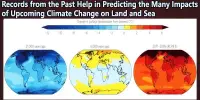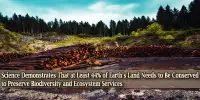The study of interactions between the physical, chemical, and biological components of the environment is known as environmental science. Environmental science teaches us how to maintain our environment in the face of rising human population and anthropogenic activities that destroy natural resources and ecosystems.
Environmental education need more investment and innovation if future generations are to be adequately prepared to respond to the climate emergency, according to experts. Researchers have warned that if major support and investment in environmental and science education is not made, the escalating environmental catastrophe would worsen. Reforms would assist young people in dealing with our current situation’s complicated, interconnected, and dynamic difficulties.
According to the experts, governments and other organizations must allocate greater financing to education innovation in response to scientists’ constant warnings about trends in the deterioration of ecosystems, biodiversity, and climate, among other environmental challenges.
The journal’s senior editors, Alan Reid from Monash University, Justin Dillon from the University of Exeter, Jo-Anne Ferreira from the University of Southern Queensland, and Nicole Ardoin from Stanford University, write in Environmental Education Research that environmental education is a “cornerstone for the social and environmental changes” that will be required in the future.
Only by investing in education, particularly environmental and sustainability education, will it be possible to dramatically alter the road we are now on, and therefore demonstrate to ourselves and future generations that sufficient regard was paid to our warnings.
Professor Ardoin
Environmental and science education helps people recognize false information and ideas, as well as understand and respond effectively to climate emergency warnings. Environmental education is a process that allows people to learn about environmental issues, solve problems, and take action to help the environment. As a result, people have a better understanding of environmental challenges and the ability to make educated and responsible decisions.
They go on to say that reaching an agreement on our environmental problems isn’t just an issue for experts. It must be supported by people in the humanities, arts, and social sciences, as well as the general public. Only then will recent requests by organizations such as UNEP and UNESCO for “environmental education to be a core component of all education systems at all levels by 2025” have a hope of receiving the international and multileveled support that the situation so desperately requires.
The scholars cite international studies that demonstrate many governments continue to underfund and underinvest in environmental and sustainability education at the pre-school, elementary, secondary, and college levels.

According to Professor Ferreira: “The research foundation is unequivocal about the superiority of whole-school approaches over fast curriculum adjustments for dealing with issues like the climate emergency. The existential risk features necessitate an examination of investment and innovation in lifetime learning and non-school based services, as well as an examination of the existing concentration of initial teacher education and continuing professional development.”
According to Professor Reid: “The popularity of outdoor education centers and activities reflects a broader interest in the environment and nature, as well as when the arts, media, and civil society address the climate problem. Flagship environmental and science communication documentaries such as David Attenborough’s investigation into the causes and consequences of the climate disaster whet many people’s appetites for learning more from reliable sources. Sir David’s own learning experience in understanding the gravity of the situation highlights the tremendous learning possibilities open to all of us, particularly in the run-up to COP26 in Glasgow.”
“Ensuring that any type of environmental education is relevant, coherent, fit for purpose, suitably supported, and available to current and future generations within and outside the curriculum will be critical to addressing sound and pertinent scientific warnings,” he added.
According to Professor Dillon: “To mitigate the effects of the environmental disaster, global leaders should consider how to reinvent, regenerate, and repair environmental education. Countries should integrate environmental and science education into the fabric of society in ways that make sense on a local level.”
“Only by investing in education, particularly environmental and sustainability education, will it be possible to dramatically alter the road we are now on, and therefore demonstrate to ourselves and future generations that sufficient regard was paid to our warnings,” Professor Ardoin stated.
The world has never confronted so many major environmental issues as it does today. CO2 emissions and the resulting climate change could be enough to bring the Earth to an end, much alone plastic pollution, overfishing, overexploitation, deforestation, biodiversity loss, and the illegal wildlife trade. These are exceptional times that necessitate large-scale behavioral changes in order to preserve a habitable Earth for future generations.
















